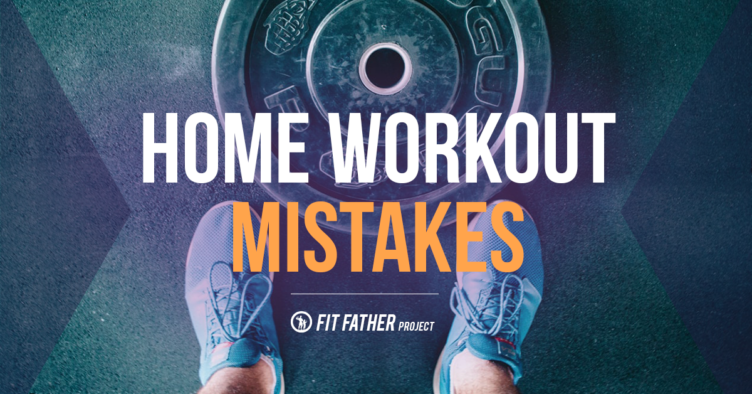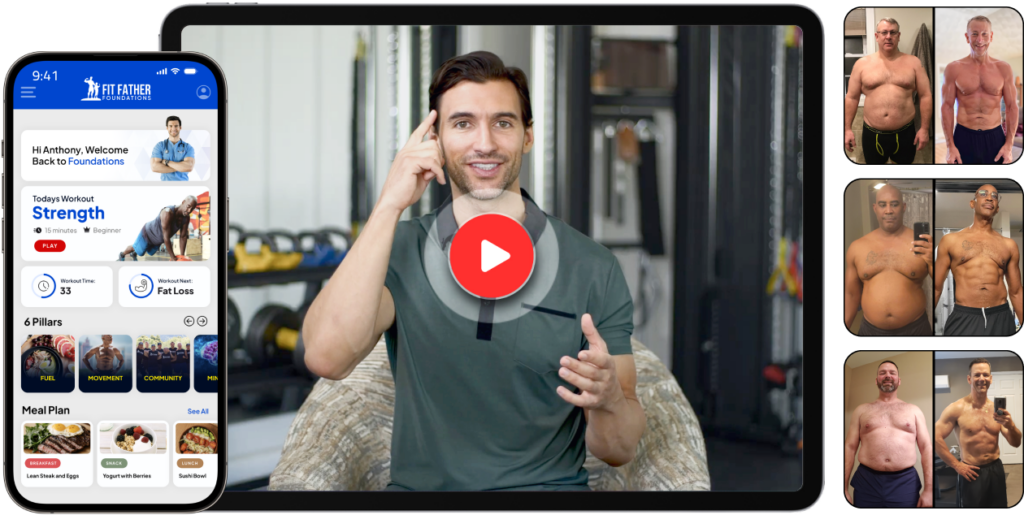Feel like you're doing all the wrong things when you exercise at home? Don't worry, home workout mistakes are common, even for seasoned professionals!
You can get a good workout in at home — you just need the right plan.
Avoid the following home workout mistakes whenever possible to exercise safely, build muscle or burn fat, prevent injuries, and look and feel your best.
15 Home Workout Mistakes to Avoid
1. Not Taking a Day Off
While it's important to keep your body moving every day, not taking a day off from strenuous exercise or weightlifting can do more harm than good.
A recent study published in Chronic Diseases and Translational Medicine found that excessive exercise can cause:
- Sports injuries
- Social-occupational dysfunction
- Nausea
- Hypoglycemia
- Chest distress
- Chest pain
- Chronic musculoskeletal pain
- A weakened immune system
Too much exercise can also prevent you from experiencing the strong workouts and muscle gains you desire, as your body needs time to heal.
To optimize results, aim to stay active every day but take a day or two off each week from strenuous exercise.
2. Lifting Too Heavy
If you're lifting weights that are too heavy, it's nearly impossible to use proper form during muscle-building sweat sessions.
Start your workout with lighter weights to warm up your muscles properly, and work your way up to lifting heavier weights.
Always make sure you use proper form. If you don't, your risk of injury and not getting the results you desire increases.
Use weights that allow you to complete at least four sets of six to 12 repetitions to increase strength and muscle mass.
If your goal is muscular endurance, use lighter weights so you can safely complete at least three to four sets of 15-20 (or more) repetitions using proper form.
Over time, increase the amount of weight you lift while keeping correct lifting techniques.
3. Lifting Too Light
Just like lifting too heavy might not get you the results you desire, lifting weights that are too light won't either.
If your goal is increased strength or muscle mass, increase the amount of weight you lift and fuel your body properly to stimulate muscle protein synthesis.
Make sure you always use proper form when lifting heavier weights, or use back or joint support gear.
The National Academy of Sports Medicine recommends completing four to six sets of six to 12 repetitions to maximize muscle building and strength.
Try this 35-minute, at-home, full-body workout to get the muscle gains you desire.
4. Skipping Cardiovascular Exercise
One of the biggest home workout mistakes you can make is skipping cardiovascular exercise.
While weightlifting at home might seem easier or more desirable, combining resistance training with aerobic exercise is ideal for muscle building and burning fat.
Doing so helps you maintain a healthy weight and optimal cardiovascular health.
Aim to get in at least 30 minutes of cardiovascular exercise most days of the week.
Complete 30 minutes of jogging, cycling, elliptical workouts, rowing, stair climbing, or walking. Or, try circuit training workouts that combine aerobic exercises with resistance training to get shredded fast.
5. Doing Too Much Cardio
If muscle building is your goal, avoid doing too much cardiovascular exercise and not enough resistance training.
Too much cardio can increase your risk of injuries and make muscle building difficult, especially if you're not eating enough protein or total calories.
To maintain or build lean mass, lift weights most days of the week and get at least 20-30 minutes of cardiovascular exercise in just about every day.
Bump up your cardio to 45-60 minutes if you have a significant amount of weight to lose, but make sure to properly fuel your body and add resistance training to most of your workouts.
6. Getting Too Little Sleep
To maintain the lean physique you desire, make sleep one of your top priorities.
Studies show that chronic sleep deprivation can alter hormone levels in your body, causing increases in appetite and your risk of unwanted weight gain.
Fatigue associate with too little sleep can make workouts of any kind seem strenuous.
You might even forgo workouts entirely because you feel too tired.
So how much sleep is enough?
Most sleep guidelines, including those set by the Centers for Disease Control and Prevention (CDC), recommend adult men get at least 7 hours of sleep each night to optimize health and wellness, reduce the risk of disease, and diminish mental fatigue.
7. Not Fueling Your Body Properly
One of the most common home workout mistakes you can make involves not fueling your body properly.
This mistake is detrimental to body composition results and your overall health, as diet is often more effective than exercise for weight and fat loss.
Fuel your body before and after workouts with a balance of protein and carbohydrates.
Pre- or post-workout snacks to consider include:
- A protein powder smoothie with fruit
- Protein bars
- Greek yogurt with fruit
- Toast with eggs and avocado slices
- Fruit with nut butter
- Pretzels or pita chips with hummus
- Eggs with quinoa and avocado
- A chicken and veggie wrap
- Fruit or nuts with cottage cheese
- Kefir
- Nuts and dried fruit
- Protein pancakes
- Weight loss breakfast recipes
At mealtimes, fill half of each plate with non-starchy vegetables, a quarter of nutritious protein foods, and a quarter of fiber-rich starches.
Eat small, frequent meals throughout the day to maintain your body's metabolism, optimize muscle building, and keep energy levels high.
Steer clear of added sugar, white bread and other refined grains, fried foods, baked goods, sodas, and sweet treats.
Eating too much is another common mistake many people make when they increase the workout intensity or duration of at-home workouts.
Just because you work out daily doesn't mean it's OK to forgo clean eating.
To get the results you desire from regular exercise, avoid eating too many total daily calories or empty-calorie foods.
8. Drinking Too Little Water
Not drinking enough water throughout the day can take a toll on at-home workouts, energy levels, and your overall quality of life.
If weight loss is your goal, drinking too little water decreases your chance of success.
How much water is enough for men?
Everybody is different, but the Institute of Medicine recommends most men get about 16 cups of fluids daily.
You might need more or less depending on your size, metabolism, muscle-to-fat ratio, and the amount of fluid you sweat out daily.
To make sure you're drinking enough water and other fluids, track your fluid intake throughout the day.
If you're getting enough, your urine should be light yellow or clear in color, rather than dark yellow or brown.
Add ice to water or flavor it with lemon, lime, fruit chunks, cucumber, or mint if you'd like.
Carry a water bottle with you all day long to meet fluid goals, enhance workouts, and optimize your health.
If weight loss is your goal, drink about 2 cups of water before each meal to help you feel full and increase your metabolism.
Steer clear of sugary drinks like soda, sweet tea, and other sugar-sweetened beverages.
9. Doing the Same Workout Routine Daily
A common home workout mistake is completing the same workout day after day.
While getting regular exercise is important, so is changing up your routine.
Doing so optimizes your results, prevents muscle fatigue, enhances muscle-building, and keeps body fat low.
Aim for variety, completing different workouts each day of the week.
Choose cardiovascular exercises like jogging, cycling, rowing, playing basketball, or using an elliptical machine.
Change up resistance-training exercises each day, too.
For example, don't train your biceps, back, or legs two days in a row.
Give each muscle group a chance to recover before repeating the same workout.
10. Working Out with Low Testosterone
If you suffer from hormone imbalance, such as low testosterone, thyroid hormone issues, or high estrogen levels, you likely won't get the muscle-building results you desire.
Your doctor can use a simple blood test to evaluate your hormones, and offer treatments to correct low testosterone and other hormone problems to give you a boost of energy, diminish thinning hair, increase lean body mass, and reduce body fat.
11. Not Pushing Yourself Hard Enough
It can be difficult to push yourself hard during at-home workouts, but giving too little effort means you likely won't achieve the lean body you desire.
To get the motivation needed to push yourself more than you normally would at home, try:
- Working out with a friend or family member
- Completing virtual workouts with an instructor
- Trying Fit Father Project workout routines
- Listening to motivational music
- Setting personal goals for workout duration and intensity, and increase goals over time
- Considering high-intensity interval training
Having structured workouts to follow and setting goals are some of the best ways to boost workout intensity and avoid common home workout mistakes.
Change up your exercise routine regularly to prevent boredom.
12. Not Having a Plan
Begin each workout with goals in place, as improper planning is one of the worst home workout mistakes you can make.
While it's important to listen to your body during exercise, not setting goals makes it easy to bail out of workouts too soon or not push yourself hard enough.
If you're new to working out, start with small goals of getting at least 20 minutes of exercise in each day.
Work your way up to longer and more intense workouts, or increases in activities of daily living, such as yard work or walking the dog, in addition to scheduled exercise.
13. Working Out On an Empty Stomach
You might be tempted to work out on an empty stomach during at-home sweat sessions, but doing so can make exercise seem difficult.
You may not have as much energy during fasting workouts.
And while some studies show benefits of fasting cardiovascular exercise for fat loss, other studies found no differences between body composition changes in fasting study subjects versus those who didn't fast before workouts.
Exercising on an empty stomach is entirely up to you, but keep in mind you may have a more intense, higher-energy workout after fueling your body with nutritious foods.
Avoid overeating, however, as doing so can drag you down or make you feel sick.
14. Forgoing Resistance Training
It's great to get in cardio most days of the week, but don't forget about resistance training as it's the best way to build muscle and get the chiseled physique you desire.
Cardio is important for overall fitness, fat burning, and heart health, but forgoing weightlifting is one of the biggest home workout mistakes you can make.
If you don't have weights at home, use milk jugs filled with water, resistance bands, or even your own body weight as resistance.
For best results, complete resistance training most days of each week.
15. Wearing the Wrong Gear
Just because you work out at home doesn't mean you should forgo wearing proper workout gear while exercising.
While you don't have to make a fashion statement during at-home workouts, it's still important to wear clothes and shoes that fit comfortably!
Not having the right gear during exercise increases your risk of injuries.
If you have a past injury that feels weak or unstable, consider compression garments or a brace for added support.
Make Home Workouts More Effective
If you have any amount of open space in your house you can participate in home workouts, with or without exercise equipment.
The Fit Father Project offers numerous at-home workouts for men, for times you can't (or don't want to) leave the house.
Set aside time each day to prioritize scheduled exercise, in addition to engaging in activities of daily living throughout the entire day.
Join the Fit Father Project community to receive fat-burning workouts, motivational support, weight loss or muscle building workouts, menus, recipes, and much more!
The FFP team personalizes each program to help you stick with healthy habits for life, while avoiding common home workout mistakes.
Sign up for the Fit Father Project free diet and workout plan to get started today!
Erin Coleman is a registered and licensed dietitian with over 15 years of freelance writing experience. She graduated with her Bachelor of Science degree in nutritional science from the University of Wisconsin-Madison, and completed her dietetic internship at Viterbo University in La Crosse, Wisconsin. Prior to beginning her career in medical content writing, Erin worked as Health Educator for the University of Wisconsin-Madison Department of Internal Medicine. Her published work appears on hundreds of health and fitness websites, and she’s currently working on publishing her first book! Erin is a wife, and a Mom to two beautiful children. The FOUNDATIONS Program is created by Dr. Anthony Balduzzi for Men 40+ who want Lifelong Health. In just 6-Weeks following FOUNDATIONS, you'll experience: FOUNDATIONS has transformed 60,000 lives! Are you ready to experience true lasting health & results?Erin Coleman, B.S. Nutritional Science, R.D., L.D.
Writer, Fit Father ProjectJoin our 6-Week Doctor Designed Health Program. You'll Gain Foundational Health for the Rest of Life.












